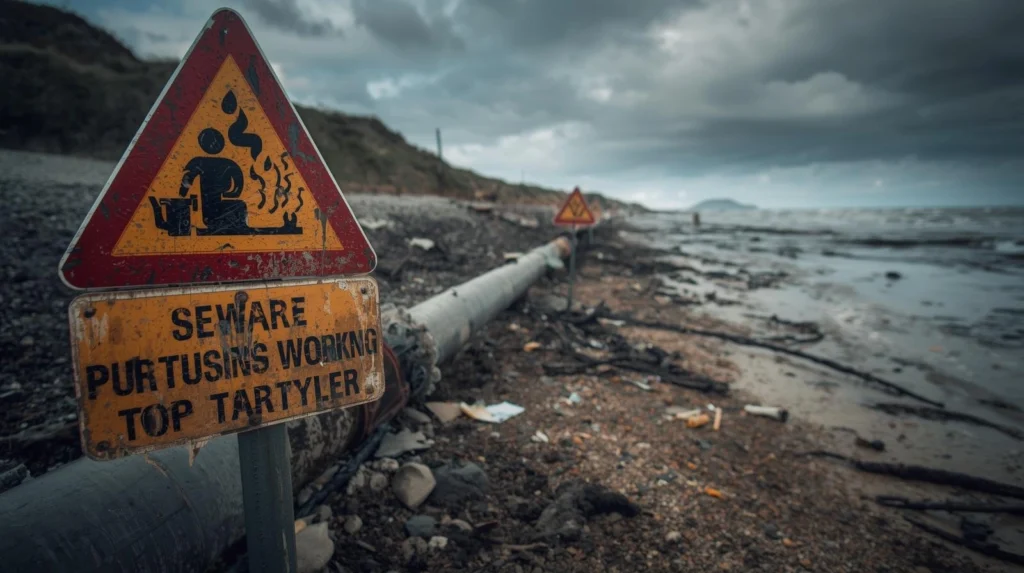What Has Happened on the Beach?
A recent increase in sewage pollution alerts along an East Yorkshire beach has raised concerns among locals and visitors. Authorities have identified damaged underground pipes and malfunctioning valves as the main contributors to this environmental issue. Over the past two years, pollution alerts have escalated significantly, prompting an urgent investigation into the cause.
Data collected by environmental monitoring groups show a stark rise in alerts: in 2024 alone, there were 31 pollution notifications, compared with just four in 2022. This sharp increase has prompted authorities and water companies to take immediate action to prevent further contamination and restore public confidence in the beach’s water quality.
Causes of the Pollution Alerts
Investigations revealed that ground subsidence had caused damage to two critical underground pipes. One plastic pipe was found compressed into an unusual oval shape, while a concrete pipe had partially collapsed. These damages allowed groundwater to seep into the sewer system, inadvertently triggering the pollution alert system.
In addition, two valve flaps within the sewer system were damaged, allowing seawater to enter the combined sewer overflow. This unintended inflow further contributed to the false activation of pollution alerts, making it seem as if the sewage contamination was higher than it actually was.
Experts explained that these mechanical failures created a scenario where both freshwater and seawater entered the system at abnormal rates. This interference disrupted the monitoring sensors, triggering alerts to warn the public of potential contamination even when the actual risk was minimal.
Repair Plans and Investments
The water company responsible has pledged to invest £1.3 million in repairing the damaged infrastructure. Engineers are working to replace the collapsed and compressed pipes and repair the malfunctioning valves to ensure the sewage system functions correctly.
This repair work is part of a larger coastal investment program, totaling £300 million over five years, aimed at improving infrastructure along the East Yorkshire coastline. These efforts include upgrading sewer systems, preventing groundwater infiltration, and enhancing water quality monitoring to reduce future false alerts.
The goal of these repairs is not only to fix the current issues but to provide a long-term solution that ensures reliable wastewater management, protects the coastal environment, and maintains safe bathing water standards for beachgoers.
Public Concerns and Perceptions
Visitors and local residents have reported a decline in confidence regarding the beach’s cleanliness. Some have avoided swimming due to fears of contamination and past incidents of sewage spillage. Residents emphasize the importance of accurate information about water quality to make informed decisions about visiting the beach.
Concerns were heightened after past environmental incidents, which have left some beachgoers wary. While the pollution alerts were sometimes triggered by technical issues rather than actual sewage spills, the perception of risk has impacted public trust.
Local residents expressed the need for transparent communication from authorities, ensuring the public receives clear and accurate updates about water quality and infrastructure improvements. Effective information dissemination can reassure visitors and encourage continued use of the beach.
The Importance of Infrastructure Maintenance
This situation highlights the critical role that well-maintained water infrastructure plays in environmental protection and public health. Underground pipes and valves are essential components of the wastewater management system, responsible for transporting sewage safely to treatment facilities. Any damage or failure can have cascading effects, from triggering false pollution alerts to posing potential health hazards.
Regular inspections, timely maintenance, and investment in robust materials can prevent similar incidents. This case also demonstrates the need for continuous monitoring, both of physical infrastructure and automated alert systems, to ensure they function as intended and provide accurate data.
Future Steps and Expectations
The repair work is scheduled for completion by the end of June, with ongoing monitoring planned to verify system reliability. Authorities aim to restore public confidence and ensure that pollution alerts accurately reflect real environmental conditions.
As part of broader initiatives, upgrades to coastal sewer systems are being implemented to handle both normal operations and extreme weather events, reducing the risk of contamination and improving resilience. Communities can expect clearer reporting on water quality and enhanced safety measures for beach activities.
Conclusion
The increase in sewage pollution alerts on this East Yorkshire beach has been traced back to damaged pipes and malfunctioning valves. Through a significant investment program and dedicated repair efforts, authorities are addressing these issues to protect both public health and the local environment. While the alerts have raised concerns among residents and visitors, the ongoing repairs and infrastructure upgrades promise a safer, cleaner coastal experience in the coming years.
This situation underscores the importance of proactive maintenance, robust monitoring systems, and transparent communication to prevent unnecessary panic and maintain confidence in public facilities. With the planned improvements, the beach is expected to continue providing a safe and enjoyable environment for everyone.


